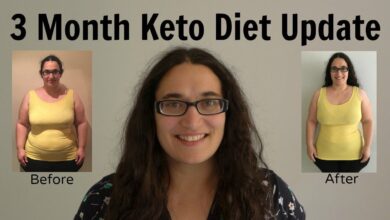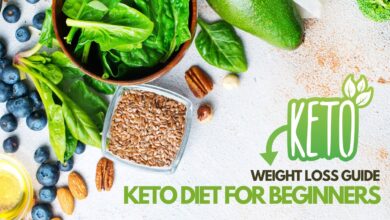
If you’ve been riding the keto wave and suddenly found your energy flatlining, your progress stalling, or just feeling a little lost with the whole thing — you’re not alone. The good news? It’s totally possible to revitalize your keto journey with a little scientific savvy, a few tweaks, and some smart habits that bring your metabolism back into sync. In this post, we’ll dig deep (yes, deep) into how your body reacts to a keto diet, how to reignite your momentum, and how to do it in a way that’s sustainable, enjoyable and grounded in research. Let’s get into it.
Read Also How to Overcome Keto Plateaus: Proven High-Impact Strategies
What Is the Keto Diet and Why Do People Use It?
Before we recharge the engine, we need to understand how it works. The ketogenic diet (keto for short) is a high-fat, very low-carbohydrate eating plan. The idea: by restricting carbs drastically, you push your body into a metabolic state called ketosis, where you burn fat for fuel instead of glucose. (Healthline)
People use keto for all kinds of reasons: weight loss, improved blood sugar control, better energy levels, sometimes even brain-health benefits. For example, studies show that keto can help with weight reduction and insulin regulation. (PMC) In short: it offers a powerful metabolic shift that many find exciting.
Why Your Keto Journey Might Be Stalling
Here’s the honest truth: starting keto often brings quick wins (hello, water weight and initial fat loss), but then the road-plateau sets in. Why?
- Your body may adapt to the low-carb state, reducing the fat-burning “boost” you first got.
- Nutrient gaps or micro-imbalances can slow you down.
- Your carbohydrate threshold might creep up without you even noticing.
- Your mindset might shift from momentum to maintenance too early.
In fact, experts point out that while keto shows strong short-term results, long-term adherence and outcomes are less well-understood. (Harvard Health) So, if your keto engine feels like it’s sputtering, it’s usually not you—it’s the stage of the journey.
*Science-Backed Foundations for a Revitalized Keto
Understanding Ketosis: The Metabolic Shift
Ketosis isn’t just a buzzword. It’s a real physiological state. In keto, because your carbs are low, your liver starts converting fat into ketone bodies (like beta-hydroxybutyrate) which your brain and body can use for energy. (PMC) That shift changes how your metabolism works, how your appetite behaves, and even how your hormones respond. So, to revitalize your keto journey, re-grounding yourself in the fundamentals of ketosis helps: Are you really in ketosis? Are you giving your body the features of the state it needs?
Key Benefits Explained by Science
Yes, the keto diet offers tangible perks when done well:
- Weight loss plus reduction in visceral fat. (PMC)
- Better appetite control: high fat, low carbs tends to reduce hunger for many people. (Healthline)
- Improved markers: some studies show improved blood sugar, insulin sensitivity, lipid profiles (with caveats). (NCBI)
- Potential brain-health benefits: ketogenic metabolism may support brain function thanks to ketone usage and reduced glucose fluctuations. (Medical News Today)
Knowing these scientific foundations gives you something concrete to build on — and revitalize.
So Why Did My Progress Slow? Common Pitfalls and How to Fix Them
When your momentum stalls, it’s rarely because your willpower failed. It’s usually one (or more) of these sneaky factors.
Carb creep and hidden carbs
You might think you’re staying low-carb, but sneaky sources of carbs (condiments, hidden sugars, dressings, drinks) can push you out of ketosis or raise your insulin responses enough to slow fat-burning. A refresher check of your macros can help.
Inadequate fat or protein adjustment
If you cut carbs but don’t balance your fats or proteins well, your body might struggle to adapt. Remember: keto is high-fat, moderate-protein, very-low-carb. According to a guide from Healthline: standard keto might be ~70% fat, ~20% protein, ~10% carbs. (Healthline) If you drop carbs but don’t raise fat suitably, you might feel fatigued or slow.
Nutrient deficiencies and gut health neglect
Low carb diets, especially if overly restrictive, can miss out on fibre, micronutrients, and healthy gut-friendly foods. One review noted that keto may reduce intake of foods typically protective in epidemiological studies. (Frontiers) Without these, your metabolism, energy, and general wellness suffer.
Lack of variation and metabolic adaptation
Your body adapts. If you’ve been on the same keto pattern for months with no tweaks, your metabolism may stop responding the way it did early on. A smart variation or “keto vacation” might be your friend (more on that later).
Overlooking lifestyle factors: sleep, stress, exercise
Keto is a big piece of the puzzle — but not the only one. Poor sleep, high stress, minimal physical activity undermine the best diet. Even with perfect macros, your physiology suffers when you ignore these.
Step-by-Step: How to Revive Your Keto Journey
Let’s roll up our sleeves. Here’s a science-driven plan to inject new life into your keto journey.
Step 1: Revisit your baseline – reset and evaluate
Start with a reset. Track your current macros for a week: carbs, fats, proteins, fiber. How many hidden carbs are sneaking in? How many nutrients (fiber, micronutrients) are you getting? Use that baseline to decide how to improve.
Step 2: Optimize your macros for your goals
Depending on whether you’re focused on fat-loss, maintenance, or body-composition change, your macro ratio may vary. For example:
- Fat-loss: lower carbs (20-30 g/day), moderate protein, high healthy fats.
- Maintenance: perhaps slightly higher carbs (30-50 g/day) and adjust fats accordingly.
Make sure you’re getting enough healthy fats (olive oil, avocado, fatty fish) rather than just saturated processed fats. Why? Because diet quality matters for health outcomes. (Medical News Today)
Step 3: Improve the quality of your fats and proteins
You might be on keto, but if you’re eating solely bacon, cheese, processed meats, your health may suffer long-term. Instead: choose leaner proteins, fatty fish, plenty of low-carb veggies, olive oil, avocado, nuts. The source of fats and the quality of foods affect cholesterol profiles, inflammation, and sustainability. (Northwestern Medicine)
Step 4: Enhance micronutrients and fiber
Even on low carbs you can and should eat fiber-rich, low-carb vegetables (leafy greens, cruciferous veggies, etc), nuts, seeds. Supplement or deliberately include magnesium, potassium, sodium especially early on (to avoid the “keto flu”). Make sure you’re not missing vitamins. One review cautioned keto often reduced intake of protective foods. (Frontiers)
Step 5: Introduce strategic variation or “keto vacations”
Believe it or not: some science suggests that continuous, strict keto can lead to unwanted effects. For example, a study found long-term continuous ketogenic diet may accumulate aged cells in normal tissues. (UT Health San Antonio) That’s not saying avoid keto forever, but perhaps build in variation: maybe cyclical keto (a little higher carb refeed once a week), or a period of more relaxed low-carb. This can help metabolism stay responsive.
Step 6: Align lifestyle – sleep, stress, movement
Your body’s metabolic engine doesn’t run on diet alone. Sleep less than 7 hours? Stress high? Movement minimal? These blunt the best macros. So: aim for quality sleep, stress-busting practices (meditation, movement, social connection), resistance training or high-intensity work to maintain muscle and metabolic rate.
Step 7: Track and adjust: don’t guess, observe
Use simple tools: weigh ins (with caution), body measurements, energy levels, hunger cues, perhaps ketone measurements (blood, urine, breath) if you like. Monitor how you feel and perform. After 4–6 weeks, review: What improved? What stalled? Then tweak.
Step 8: Set new goals to renew motivation
Sometimes you stall because your original goal is now reached or feels far away. Reset new targets: maybe body-composition rather than weight, maybe performance rather than scale, maybe health markers (blood sugar, lipid profile) rather than just aesthetics.
Advanced Science Hacks to Take Your Keto Further
Once the basics are solid, you can layer in advanced strategies—always ensuring you’re healthy and cleared for them.
Harnessing exogenous ketones & targeted supplementation
There’s growing interest in exogenous ketones (ketone salts or esters) and how they may support ketosis and performance. (Wikipedia) While not necessary for everyone, advanced users may explore them (under supervision) to support energy or mental performance.
Periodic refeed or carb cycling
Instead of an all-or-nothing approach, some folks boost metabolism and hormonal balance by incorporating a higher-carb day (still controlled) every 7–14 days. This can help reset leptin, thyroid signals, and keep your metabolism “aware”.
Leveraging targeted keto for workouts
If you’re active (especially in strength or endurance), you might use a “targeted keto” approach: a small carb intake around workouts to support performance, then back to keto for general living. This allows you to train hard while staying low-carb most of the time. (Healthline)
Monitoring metabolic markers and adjusting accordingly
Consider tracking HBA1C, fasting insulin, lipid profile, CRP (inflammation), etc. Some studies show keto improves glycemic control and lipid markers. (NCBI) If your markers stop improving or worsen, that’s a cue to adjust your plan.
Emphasizing mitochondrial health and brain function
Ketones may offer neuro-protective benefits and improved mitochondrial efficiency (energy factories in cells). (PMC) So layering in high-quality sleep, intermittent movement, and nutrients that support mitochondria (omega-3s, B-vitamins, antioxidants) amplify your keto gains.
Special Considerations for Africa, United States & Europe
Whether you’re in Accra, New York, Berlin or London—a revitalized keto plan needs local adjustments and awareness of cultural, food-supply and health-system factors.
Food access and local versions of keto foods
In Africa, you might rely on plantains, cassava, fresh fish, groundnuts, avocados versus US/Europe’s keto staples (almonds, cheese, bacon). Adjust: high-fat local foods (coconut oil, avocado, fish, eggs) count. In Europe and US you have a wide selection of keto-specialized products, but also more processed temptations. Choose whole foods when possible.
Cultural eating patterns and flexibility
In many African cultures, communal meals, staples like nshima, fufu, rice are normal. The key: you don’t need zero carbs forever—just control them. In US/Europe, social eating often involves bread, pasta, sugary drinks. Plan ahead: bring keto-friendly sides, share your journey, or find healthy versions of cultural dishes.
Healthcare context and metabolic risks
Rates of type 2 diabetes and metabolic syndrome vary across regions. In the US, Europe and increasingly in Africa, insulin-resistance is a big concern. Because keto has shown improved insulin sensitivity in some studies, it may be especially relevant. (Home) But also: always consult a health professional if you have chronic conditions (e.g., kidney disease, liver disease) because keto may not suit everyone. (Northwestern Medicine)
Localized food pricing and cost-effectiveness
High-fat foods (nuts, fish, avocado) may cost more in some regions. Simple strategies: use eggs, local fatty fish, coconut oil, groundnuts, full-fat dairy (if available and tolerated). Use seasonal vegetables to stay on budget.
Environment, climate and hydration
In warmer climates (for instance West Africa) dehydration risk can be higher. On keto, your water and electrolyte needs change (you store less glycogen, so water drops). Make sure you’re drinking enough, replenish sodium/potassium especially if you sweat a lot. In cooler climates (US/Europe winter), support your immune system with nutrient-rich keto foods because low carb plus cold weather can stress energy reserves.
Troubleshooting Common Keto Issues
Even with a revitalized plan, things can still go off track. Here are some common issues and fixes.
Keto flu / low energy
Feeling foggy, weak, irritable? Could be carb-cut shock or electrolyte imbalance. Fix: raise water intake, boost sodium/potassium/magnesium, eat a few more carbs (still low) for a day, ensure fat intake is adequate.
Digestive issues and low fiber
Constipation on keto is common because some people drop carbs (and fiber) drastically. Fix: include more low-carb fibrous veggies (broccoli, kale, spinach), chia seeds, flax seeds; consider a gentle fiber supplement; stay hydrated.
Lipid profile or cholesterol issues
If you notice your LDL or total cholesterol rising, don’t panic—but examine fat sources. High intake of processed saturated fat (sausages, bacon, butter) might be the culprit. Shift to mono- and polyunsaturated fats (olive oil, avocado, nuts, fatty fish). Some research suggests diet quality influences results. (Northwestern Medicine) Monitor with your physician.
Stalled weight loss
If the scale or mirror aren’t changing: revisit your macro intake (are you eating more calories than you think?), increase physical activity (especially resistance training), consider a slight calorie deficit or temporal carb-cycling. Also check sleep and stress—they affect your hormones.
Cravings and social pressure
Keto can be socially isolating (especially where carb-rich meals dominate). Plan: bring your own dish, communicate your goals to friends/family, allow a “free meal” occasionally with good choice rather than “fall off the wagon.” Having a support network helps.
Case Study: A Revitalized Keto Journey
Imagine “Sarah” (age 38, lives in London) had been on keto for 10 months: lost 12 kg in the first 4 months, then plateaued. She’s feeling tired, her workouts are flat, she’s craving carbs again. Here’s how she used the science-backed plan above to bounce back:
- Reset & assess: tracked macros and found she was eating 45 g carbs/day (too high to stay deeply ketogenic) and fat sources were mostly processed meats and cheese. Also her fiber was low.
- Macro adjustment: she reduced carbs to 20 g/day, increased healthy fats (salmon, avocado, olive oil), protein at moderate level (lean chicken, fish).
- Quality upgrade: swapped processed meats for fatty fish + nuts; added leafy greens & seeds; replaced some butter with olive/coconut oil.
- Micronutrients & hydration: ensured she got 3000 mg sodium/day, added magnesium supplement, ate broccoli, chia seed pudding for fiber.
- Variation: she introduced a cyclical element: one “refeed” day every 10 days where carbs went to 50 g (via sweet potato + veggies) to reset metabolism.
- Lifestyle alignment: improved sleep routine (lights off by 10 pm), added 3 resistance training sessions/week + brisk walks; stress reduction via weekend yoga.
- Track & adjust: after 5 weeks she measured body composition (lost further 3 kg fat), energy returned, and workout performance improved.
- New goal: Instead of just “lose weight” she changed goal to “gain strength, improve lipid profile” which renewed her motivation.
The result? Sarah’s keto journey got a second wind—less of a drag, more of a powerful shift, with better consistency and more joy.
Long-Term Sustainability: Making Keto Work for Life
Yes, you can make keto a long-term sustainable part of your life—but it doesn’t mean rigid forever. Here are keys for longevity:
Be flexible, not fanatical
If you treat keto as a rigid prison you’ll burn out. On the other hand, if you treat it as a strategic tool, you’ll adapt with it. Maybe you go strict for 4–6 weeks, then move to moderate low-carb for 2–4 weeks, then repeat. This variation keeps your metabolism responsive.
Use real food, not just “keto products”
Real food means veggies, quality fats, whole foods—not relying on isolated processed keto snacks. Over time real food sustains health, gut microbiome, energy. Research warns against diets that drop protective foods just because carbs are restricted. (Frontiers)
Reassess regularly
Every 3–6 months review: weight, body composition, blood work, how you feel, your psychological relationship with food. Adjust accordingly.
Integration with lifestyle phases
If you travel, socialize, have family meals, you’ll need flexibility. Pre-plan your meals, pack keto-friendly snacks, choose lower-carb sides when dining out, or allow a higher-carb meal and return to low-carb the next day. The key: return to your baseline, don’t derail entirely.
Mindset: keto as long-term health tool, not just quick fix
Treating keto as “lose weight fast and done” sets you up for burnout. Instead: view it as a metabolic-enhancer, a health-tool, a new baseline of eating that supports energy, wellness and longevity. That mindset shift is key to revitalizing and sustaining it.
When Keto Might Not Be Right (Or Needs Extra Care)
Keto is not a universal silver bullet. There are situations where caution or modification is required.
Medical conditions requiring supervision
If you have kidney disease, liver disease, pancreatitis, are pregnant or breastfeeding, or taking certain medications (especially for diabetes) you must consult a healthcare provider before going full keto. (Medical News Today)
Long-term unknowns and monitoring
While short-term benefits are strong, long-term effects (5-10-20 years) of strict keto are less studied. A recent study suggested continuous long-term keto may cause accumulation of aged cells in some tissues. (UT Health San Antonio) So long-term users should monitor their health markers, not just weight.
Psychological risks and relationship with food
Some people use diets to control, restrict, and this may trigger disordered eating patterns. If you feel guilt, shame or obsession with ketosis, step back and consider a more balanced low-carb approach until your mindset is stable.
Performance or athletic demands
If you are a high-volume endurance athlete or rely on high-intensity bursts (e.g., sprinting, team sports), you may need more carbs or targeted keto. One size does not fit all. Tailor accordingly. (Healthline)
Real Food Keto Meal Framework for a Revitalized Plan
Here’s a sample framework you can adapt depending on your region (Africa, US, Europe) and preferences. Use local, whole foods.
Breakfast ideas
- Eggs + avocado + spinach sautéed in olive oil (Africa: maybe eggs + smoked fish + sautéed greens + avocado)
- Full-fat Greek yoghurt (or suitable local equivalent) with chia seeds + chopped nuts + a few berries (if carbs allow)
- Omelet with mushrooms, cheese, and side of steamed kale
Lunch ideas
- Grilled fish (salmon, mackerel) with mixed greens, avocado, olive oil dressing, and roasted nuts/seeds
- Chicken breast with cauliflower rice, broccoli florets and coconut oil drizzle (Africa: maybe cauliflower rice with groundnuts)
- Salad: mixed greens, olives, feta (or local cheese), cucumber, pumpkin seeds, dressed with olive oil and lemon
Dinner ideas
- Beef stir-fry with low-carb vegetables (bell pepper, zucchini, broccoli) in coconut oil (Africa: maybe lean beef + okra + smoked tomato sauce)
- Salmon with asparagus and butter-garlic sauce + side of sautéed spinach
- Pork tenderloin (or appropriate local protein) with cauliflower mash and side of green beans
Snacks and extras
- Nuts & seeds (almonds, walnuts, pumpkin seeds)
- Cheese slices or full-fat cottage cheese (if dairy tolerated)
- Olives, sliced avocado
- Hard-boiled eggs
- Keto-friendly bars or dark chocolate (90% cocoa, minimal carb) when needed
Hydration and electrolyte booster
- Water (stay well hydrated)
- Add a pinch of salt to your water if needed, or drink broth (especially in hot climates)
- Electrolyte-rich veggies or supplements: magnesium, potassium, sodium
This real-food framework keeps you grounded, satisfied, on track—and primes your body for optimal keto performance.
Measuring Results: What to Track & How to Interpret
Metrics that matter (beyond the scale)
- Body composition: fat mass vs lean mass (use tape measure, calipers or body-scan)
- Energy levels: how you feel during day, workouts, sleep quality
- Hunger and satiety: are you less hungry, craving less?
- Lab markers: fasting glucose, insulin, HbA1c, lipid panel (HDL, LDL, triglycerides), CRP, etc
- Ketone levels (optional): using blood/urine/breath meters if you like quantification
- Performance metrics: strength, endurance, how you recover from workouts
Interpreting progress thoughtfully
when weight stalls: check calories, macros, proteins, movement, sleep.
>If labs worsen: revisit fat quality, inflammation, nutrient adequacy, medical review.
>If you feel good and markers are fine but scale static: that could be lean mass gain + fat loss offsetting. Focus on how you feel, strength, measurements not just scale.
If you feel tired, weak, mood dips: revisit nutrient adequacy, electrolytes, sleep, stress, and consider a carbohydrate refeed or macro adjustment.
Motivation & Mindset: Keeping the Fire Alive
Revitalizing your keto journey is just as much about mindset as it is about macros. Let’s talk about how to keep the flame burning.
Embrace the journey, not just the destination
Your journey isn’t just about “lose X kgs” or “fit into size Y.” It’s about building metabolic resilience, energy, a relationship with food that supports your life. When you see keto as a lifestyle tool, not a quick fix, you are far more likely to stay engaged.
Celebrate small wins
Did you improve your workout performance? Got better energy mornings? Stayed consistent for two weeks? These are wins too. Celebrate them. They build momentum.
Community and accountability
Whether you join a keto-group, follow a forum, or partner with a friend, accountability helps. Share your challenges and wins. Hearing others’ stories (especially from your region) makes your journey real.
Be kind to yourself
There will be days you slip. Life happens. The goal isn’t perfection—it’s progression. If you have an off day, get back up. Use it as a learning moment, not a derailment.
Reinvent your relationship with food
Instead of “I can’t eat bread/pasta,” think “I choose foods that fuel me, give me energy, make me strong.” Shift from restriction to empowerment.
With the right mindset, your keto journey won’t feel like a burden—it will feel like your engine humming, ready for life.
Frequently Asked Questions
Below are some questions people ask when they’re trying to revitalize their keto journey.
Q1: Can I still follow keto if I’m vegetarian or vegan?
Yes — although it takes more planning. You’ll need to rely on high-fat plant foods (avocado, nuts, seeds, coconut oil), plant-based proteins (tofu, tempeh, seitan if accepted), and focus on low-carb vegetables. You’ll want to monitor nutrients like B12, iron, zinc, and possibly supplement. The core keto principle still applies: high fat, moderate protein, very low carbs.
Q2: Will I get muscle loss if I stay on keto for a long time?
It’s possible if you don’t support your body properly. To protect muscle: ensure you’re getting enough protein (not overly high, but adequate), do resistance training, and eat sufficient calories. When done well, keto can preserve lean mass. Tracking body composition helps you monitor this.
Q3: What’s a safe way to transition off keto if I want to moderate carbs later?
If you decide to move from strict keto to a more moderate low-carb diet: increase carbs gradually (add 10-20 g per week) in the form of fibrous vegetables and low-GI fruits; keep fats moderate; monitor how you feel and your energy. Transition slowly rather than a sudden carb “binge.” This helps your metabolism adjust without big swings.
Q4: How often should I measure ketones, and is it necessary?
Measuring ketones can be helpful (especially early in your journey) to understand if you’re in ketosis. But it’s not essential for everyone, especially long-term. If it adds stress, skip it. Instead focus on how you feel (energy, hunger), how your clothes fit, and other markers (weight, body composition). If you do measure, once or twice a week is sufficient for many people.
Q5: I’m hitting a plateau. Should I increase protein?
Possibly—but cautiously. Increasing protein can help prevent muscle loss and increase thermic effect (burn more calories digesting protein). But if you raise protein too much, your body might convert excess into glucose (via gluconeogenesis) which could hamper ketosis. The sweet spot: moderate protein, enough to support muscle and recovery, but not excessive. Usually around 20-25% of calories (depending on your goals, body size and activity) works well.
Conclusion
Revitalizing your keto journey isn’t about forcing yourself back into the strictest version you began with—it’s about smart upgrades backed by science, thoughtful adjustments tailored to your lifestyle, and renewing your mindset so this becomes part of your life, not just a diet. You’ve got the foundation: understanding how ketosis works, why your progress stalled, and the step-by-step plan to reignite it. So ask yourself now: what’s one tweak you’re going to make this week to bring your keto journey back alive? Maybe it’s tracking hidden carbs, maybe adding more fiber, maybe planning a “refeed” day, or simply committing to better sleep. Pick that one piece, lean into it, and watch your momentum return.
Here’s to your revitalized keto journey—stronger, smarter, sustainable.
Read Also 6 Must-Have Ingredients for Low-Carb Meal Prep: Ultimate Guide for Busy Weeks
FAQs
- Can I still use strict keto for years, or is variation better?
Strict keto can work long-term for some, but research suggests long-term continuous keto might bring unknown risks (such as cellular aging). (UT Health San Antonio) Variation (cyclical or targeted carb intake) might support better sustainability and metabolic responsiveness. - How much physical activity should I pair with keto for best results?
Aim for a mix: at least 150 minutes/week of moderate aerobic (walking, cycling) plus 2–3 strength training sessions. Strength training helps preserve lean mass; aerobic supports overall health. Keto supports this activity well when paired with proper fuel (fats) and recovery. - If I travel and can’t stick to low-carb, how do I get back on track?
Don’t stress. Do your best. On travel days, choose the lowest-carb options available (salads, protein, fats). After travel, restart stricter carb control for 2–3 days, then resume your revitalized plan. The key is consistency over time, not perfection every day. - Is keto safe for older adults (50 +)?
It can be, but older adults may need extra considerations: muscle preservation is crucial (so ensure protein + resistance training), bone health support (vitamin D, calcium), kidney and liver health monitoring, and nutrient checks. Always consult a healthcare provider for personal risks and adjustments. - How do I know when I’ve “revitalized” enough and can move to maintenance?
When you consistently feel good (energy, sleep, performance), your body composition is trending toward your goals (fat loss, strength, lean mass), your markers are healthy (blood work), and you’re able to maintain the plan without undue stress—then you’re ready for a maintenance phase. Maintenance doesn’t mean stopping keto—it means adapting it to your new baseline, possibly with more flexibility, and focusing on sustaining results rather than pushing hard for change.




